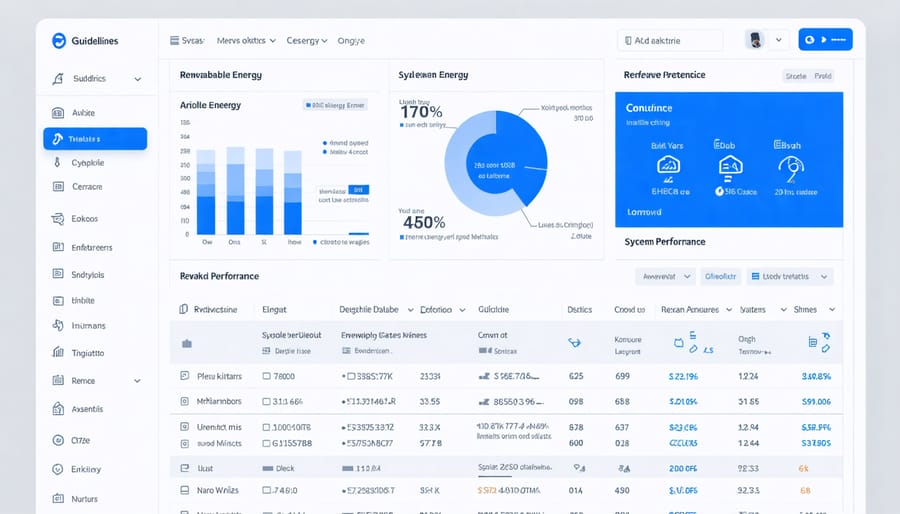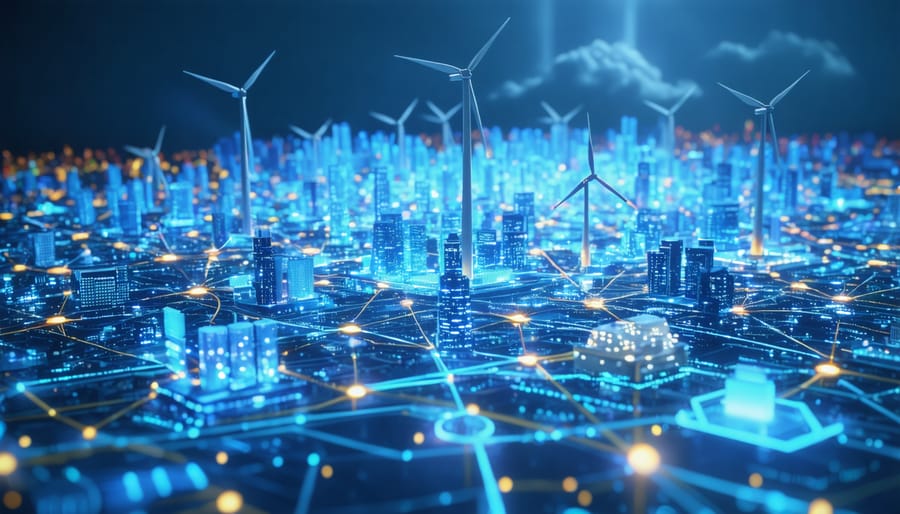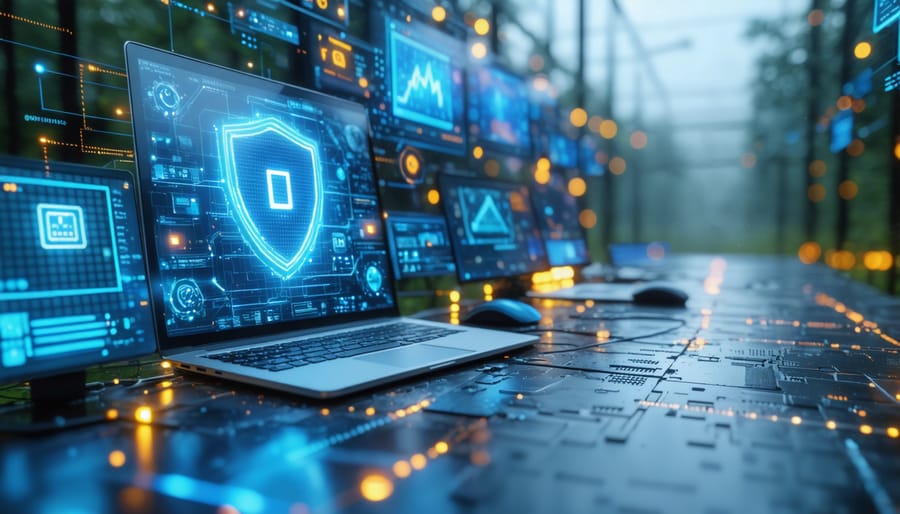As renewable energy reshapes our global energy landscape, critical questions emerge about its implementation, scalability, and integration into existing infrastructure. The digital transformation in utilities has amplified these challenges, demanding sophisticated solutions and strategic planning.
Industry leaders must address fundamental questions about grid reliability, energy storage capabilities, and the economic viability of renewable projects. How can we ensure consistent power supply during periods of low solar or wind generation? What infrastructure investments are necessary to support widespread renewable adoption? How do we balance the initial capital costs against long-term operational savings?
These questions aren’t just technical challenges—they’re opportunities to revolutionize our energy systems. As technology advances and costs decrease, the answers to these questions will shape investment decisions, policy frameworks, and implementation strategies across the renewable energy sector. Understanding these critical issues is essential for stakeholders to make informed decisions and drive successful renewable energy initiatives forward.
The following analysis explores the most pressing questions facing the renewable energy industry, offering evidence-based insights and practical solutions for decision-makers navigating this rapidly evolving landscape.
Data Analytics and System Monitoring Skills
Real-time Performance Monitoring
Effective real-time performance monitoring is crucial for maximizing renewable energy system efficiency and ROI. As one of the fastest emerging renewable energy careers, performance analysts need to master several key competencies.
Essential skills include proficiency in data acquisition systems (DAS), SCADA interfaces, and advanced monitoring platforms. Professionals should be able to interpret real-time performance metrics, including power output, conversion efficiency, and environmental factors affecting system performance. Understanding sensor technology and measurement accuracy is fundamental for reliable data collection.
Analytics capabilities are equally important, requiring familiarity with performance modeling software and data visualization tools. Analysts should be able to:
– Track key performance indicators (KPIs)
– Identify performance degradation patterns
– Generate automated performance reports
– Implement predictive maintenance protocols
– Calculate actual vs. expected energy yield
Experience with remote monitoring systems enables quick response to performance issues and optimal system uptime. Knowledge of communication protocols and network security is essential for maintaining data integrity and system security.
Successful monitoring professionals combine technical expertise with practical problem-solving skills to ensure renewable energy systems operate at peak efficiency. This includes understanding weather patterns, seasonal variations, and their impact on system performance, enabling more accurate forecasting and performance optimization.

Predictive Maintenance Capabilities
Modern renewable energy systems benefit significantly from advanced predictive maintenance capabilities, which combine data analytics, IoT sensors, and machine learning algorithms to optimize system performance. These digital tools enable facility managers to develop comprehensive solar system maintenance skills that focus on prevention rather than reaction.
Key predictive maintenance features include real-time monitoring of equipment health, performance analysis, and early warning systems for potential failures. By analyzing historical data patterns, these systems can accurately forecast maintenance needs, helping organizations reduce downtime and optimize maintenance schedules.
For example, smart sensors installed on solar panels can detect subtle changes in power output, temperature variations, or unusual vibrations that might indicate developing issues. This data, when processed through advanced analytics platforms, provides actionable insights that maintenance teams can use to address problems before they escalate.
The ROI of implementing predictive maintenance is substantial, with organizations reporting up to 25% reduction in maintenance costs and 70% decrease in system breakdowns. These systems also help extend equipment life spans and maintain optimal energy production efficiency throughout the system’s operational lifetime.
To effectively implement predictive maintenance, organizations should focus on integrating these digital tools with existing maintenance protocols and ensuring staff receive proper training in data interpretation and system management.
Smart Grid Integration Expertise

Grid Communication Technologies
Smart grid communication protocols form the backbone of modern renewable energy systems, enabling seamless integration and efficient management of distributed energy resources. These protocols facilitate real-time data exchange between various grid components, supporting innovative energy projects and optimizing power distribution.
Key communication technologies include Advanced Metering Infrastructure (AMI), which enables two-way communication between utilities and consumers, and Supervisory Control and Data Acquisition (SCADA) systems that monitor and control grid operations. These systems typically utilize protocols such as Modbus, DNP3, and IEC 61850 to ensure reliable data transmission and interoperability.
Network management in smart grids requires robust cybersecurity measures to protect against potential threats while maintaining system reliability. Implementation of encrypted communications, access control systems, and regular security audits are essential components of a comprehensive grid communication strategy.
For facility managers and business owners, understanding these technologies is crucial for:
– Optimizing energy consumption patterns
– Implementing demand response programs
– Monitoring power quality and reliability
– Integrating on-site renewable energy systems
– Managing energy storage solutions
The evolution of grid communication technologies continues to enhance the efficiency and reliability of renewable energy systems, making them increasingly attractive for commercial and industrial applications.
Energy Storage Management
Energy storage management has become a critical component in the successful implementation of renewable energy systems. Facility managers and energy professionals must develop expertise in optimizing battery storage systems to maintain grid stability and maximize return on investment.
Key skills include understanding battery chemistry and lifecycle management, implementing advanced monitoring systems, and utilizing predictive analytics for performance optimization. Professionals should be proficient in energy management software platforms that enable real-time monitoring of storage systems and automated response to demand fluctuations.
For example, the California-based Sierra Nevada Brewing Company implemented a sophisticated battery storage system that reduced their peak demand charges by 27% through intelligent load shifting and demand response participation. Their success demonstrates the importance of understanding both technical specifications and economic optimization strategies.
Essential competencies include:
– Battery system performance analysis
– Demand forecasting and load management
– Integration of storage systems with existing renewable infrastructure
– Emergency response protocols for system failures
– Cost-benefit analysis for storage deployment
Facility managers should also focus on developing skills in grid interconnection requirements, safety protocols, and regulatory compliance. Understanding utility rate structures and incentive programs is crucial for maximizing the economic benefits of storage systems.
As storage technology evolves, staying current with emerging technologies and best practices through continuous education and professional development becomes increasingly important for effective system management.
Digital Project Management Tools
3D Modeling and Design Software
Proficiency in 3D modeling and design software has become essential for renewable energy professionals, enabling accurate system visualization and optimization before physical implementation. Industry-standard tools like AutoCAD, SketchUp, and Revit allow teams to create detailed representations of solar arrays, wind farms, and other renewable energy installations.
These software platforms facilitate precise measurements, spatial analysis, and shade studies crucial for maximizing system efficiency. Engineers and designers can model different equipment configurations, analyze structural requirements, and identify potential installation challenges before breaking ground. This capability significantly reduces project risks and optimizes resource allocation.
For solar installations specifically, specialized software like PVsyst and Helioscope integrate with 3D models to simulate energy production under various environmental conditions. These tools enable teams to demonstrate project feasibility to stakeholders and provide accurate performance projections.
The ability to generate professional visualization aids is equally important for client presentations and permit applications. Modern rendering capabilities allow teams to create photorealistic images that illustrate how renewable energy systems will integrate with existing architecture and landscapes, helping secure project approval and stakeholder buy-in.
Understanding these design tools is particularly valuable for projects requiring custom mounting solutions or installations in challenging environments, where standard configurations may not be suitable.
Project Management Platforms
Effective project management platforms are essential for coordinating renewable energy installations and maintenance operations. Leading solutions like Procore, PlanGrid, and Monday.com offer specialized features for renewable energy projects, including real-time progress tracking, resource allocation, and collaborative workflows.
These platforms typically integrate key functionalities such as document management, scheduling tools, and quality control checklists specific to solar and wind installations. Cloud-based solutions enable teams to access project data from any location, facilitating communication between on-site installers, project managers, and stakeholders.
Modern project management systems also incorporate mobile capabilities, allowing field technicians to update installation progress, document safety compliance, and report maintenance issues in real-time. Features like automated reporting and analytics help teams track project milestones, monitor equipment performance, and optimize maintenance schedules.
For large-scale renewable energy projects, enterprise-level platforms offer advanced capabilities such as supply chain management, contractor coordination, and regulatory compliance tracking. Many systems also integrate with common business tools like accounting software and CRM systems, streamlining administrative processes.
When selecting a platform, organizations should consider factors such as scalability, customization options, security features, and integration capabilities with existing systems. Regular training and updates ensure team members can fully utilize these digital tools to maximize project efficiency.
Cybersecurity Awareness
Security Protocol Implementation
In today’s interconnected renewable energy systems, implementing robust security protocols is essential for protecting critical infrastructure and sensitive operational data. Organizations must establish comprehensive cybersecurity frameworks that address both physical and digital vulnerabilities in their renewable energy installations.
Key security measures should include multi-factor authentication for all system access points, regular security audits of control systems, and encrypted communications between smart grid components. Facility managers should implement network segmentation to isolate critical systems from general business networks, reducing the risk of unauthorized access.
Real-world applications have shown that successful security implementations typically involve:
– Regular vulnerability assessments and penetration testing
– Continuous monitoring of system activities and access logs
– Automated threat detection and response systems
– Secure firmware updates for all connected devices
– Employee training on cybersecurity best practices
A notable case study from a major solar farm in California demonstrated how implementing blockchain-based authentication reduced security incidents by 85% while maintaining operational efficiency. Similarly, wind farms across Europe have successfully deployed AI-powered security monitoring systems that can detect and respond to threats in real-time.
Organizations should also develop incident response plans specific to renewable energy infrastructure, including procedures for maintaining power generation during security events. Regular updates to security protocols ensure systems remain protected against emerging threats while supporting the growing integration of renewable energy resources.
Threat Detection and Response
In today’s renewable energy landscape, effective threat detection and response capabilities are crucial for maintaining the security and reliability of energy systems. Facility managers and operators must develop skills to identify potential security risks across both physical and digital infrastructure components.
Key competencies include monitoring system anomalies, analyzing security alerts, and implementing rapid response protocols. Teams should be proficient in using Security Information and Event Management (SIEM) tools to track and assess potential threats in real-time. Understanding pattern recognition and behavioral analysis helps identify unusual activities that could indicate security breaches.
Industry professionals should also master incident response planning and execution. This involves developing and maintaining comprehensive response procedures, conducting regular security drills, and updating protocols based on emerging threats. The ability to coordinate with multiple stakeholders during security incidents is essential.
Risk assessment skills are equally important. Teams need to evaluate vulnerabilities in renewable energy systems, from solar panel monitoring systems to wind turbine control networks. This includes understanding common attack vectors, conducting regular security audits, and implementing appropriate countermeasures.
Continuous learning is vital as threat landscapes evolve. Professionals should stay updated on the latest security trends, participate in industry-specific training programs, and maintain certifications relevant to renewable energy security. Regular participation in security workshops and seminars helps teams stay prepared for emerging challenges.

The digital transformation of the renewable energy sector represents a critical turning point in our pursuit of sustainable energy solutions. As we’ve explored throughout this article, developing and maintaining digital competencies is no longer optional but essential for organizations seeking to maximize their renewable energy investments and operations.
These digital skills directly impact project success rates, operational efficiency, and return on investment. Organizations that embrace digital transformation and invest in their teams’ capabilities consistently demonstrate superior performance in renewable energy implementation and management. From data analytics that optimize energy production to advanced monitoring systems that prevent costly downtimes, these skills form the foundation of modern renewable energy operations.
The impact extends beyond individual organizations to the broader energy transition. Skilled professionals who can effectively leverage digital tools and technologies are driving innovation, improving grid integration, and accelerating the adoption of renewable energy solutions across industries. Their expertise in project management platforms, modeling software, and predictive maintenance systems is essential for scaling renewable energy projects and ensuring their long-term viability.
Looking ahead, the convergence of renewable energy and digital technology will only intensify. Organizations must prioritize continuous learning and skill development to remain competitive and effective. This includes establishing training programs, partnering with educational institutions, and creating environments that foster digital innovation.
By investing in these critical digital capabilities today, organizations position themselves to lead in the renewable energy sector of tomorrow. The success of our sustainable energy future depends not just on the technology we deploy, but on the digital skills and expertise we develop to manage and optimize these systems effectively.

